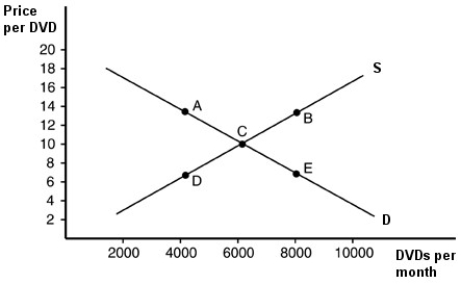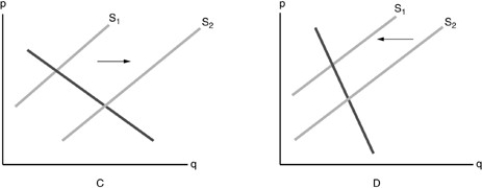A) a decrease in the demand for that product.
B) a decrease in quantity supplied of that product
C) a decrease in the supply of that product.
D) an increase in the supply of that product.
F) A) and D)
Correct Answer

verified
Correct Answer
verified
Multiple Choice
In a free market, the market price and quantity in the above figure will adjust to equilibrium values of
A) $1 per gallon and 50 million gallons.
B) $4 per gallon and 10 million gallons.
C) $2 per gallon and 60 million gallons.
D) $2 per gallon and 30 million gallons.
F) B) and D)
Correct Answer

verified
Correct Answer
verified
Multiple Choice
An indirect or inverse relationship between price and quantity demanded is
A) the market clearing price.
B) a change in demand.
C) a supply curve.
D) a demand curve.
F) B) and D)
Correct Answer

verified
Correct Answer
verified
Multiple Choice
Which of the following illustrates the law of demand?
A) More people watch college basketball in March than in November.
B) The number of long distance calls in the United States is greater on Christmas than on Valentine's Day.
C) College enrollment increases when federal tuition grants are readily available to students.
D) The prevailing wage rate in an industry determines how many people choose to work in the industry.
F) C) and D)
Correct Answer

verified
Correct Answer
verified
Multiple Choice
Which of the following is an example of the law of supply?
A) The price of gum has increased so producers are making more gum.
B) The price of labor has increased and producers decrease supply.
C) The amount of a good purchased increases when the price decreases.
D) Producers provide less of a good when the price increases.
F) B) and C)
Correct Answer

verified
Correct Answer
verified
Multiple Choice
 -According to the above figure, equilibrium is at point
-According to the above figure, equilibrium is at point
A) E.
B) B.
C) C.
D) D.
F) A) and B)
Correct Answer

verified
Correct Answer
verified
Multiple Choice
If one day a terrible disease were to wipe out over one-half of the world's lime trees, which of the following would likely result?
A) The supply curve of lime juice would shift downward and to the right.
B) The supply curve of lime juice would shift upward and to the left.
C) The demand curve for lime juice would shift to the right.
D) The demand curve for lime juice would shift to the left.
F) A) and B)
Correct Answer

verified
Correct Answer
verified
Multiple Choice
According to the above figure for a gasoline market, an increase in the price from $2 to $4 will result in
A) a shortage of 30 million gallons.
B) an increase in quantity demanded of 10 million gallons.
C) an increase in quantity supplied of 20 million gallons.
D) an increase in demand of 20 million gallons.
F) A) and C)
Correct Answer

verified
Correct Answer
verified
Multiple Choice
Which of the following does NOT cause a rightward shift in the supply curve?
A) a reduction in resource costs
B) an increase in technology
C) a reduction in the price of the good
D) a reduction in the expected future price of the good
F) C) and D)
Correct Answer

verified
Correct Answer
verified
Multiple Choice
The market supply curve can be derived by
A) vertically adding the individual supplies at each quantity level.
B) multiplying the price and quantity supplied at each price level.
C) horizontally adding the individual supplies at each price level.
D) looking at the capacity utilization in the largest firms in the industry.
F) A) and B)
Correct Answer

verified
Correct Answer
verified
Multiple Choice
A fundamental principle in demand analysis is that a change in price leads to
A) a movement along the demand curve.
B) a rightward shift of the demand curve.
C) a leftward shift of the demand curve.
D) a complementary movement on the supply curve.
F) A) and C)
Correct Answer

verified
Correct Answer
verified
Multiple Choice
Suppose that the price of cornflakes is $3 per box and the price of oatmeal is $4.50 per box. Both boxes contain the same number of ounces of cereal. The relative price of cornflakes in terms of oatmeal is
A) 0.67.
B) 1.0.
C) 0.75.
D) 1.50.
F) A) and D)
Correct Answer

verified
Correct Answer
verified
Multiple Choice
According to the law of demand, other things being equal,
A) when the price a good goes up, then people buy more of that good.
B) when the price a good goes up, then people buy less of that good.
C) when people's income goes up, then they buy more of a good.
D) when people's income goes up, then they buy less of a good.
F) A) and C)
Correct Answer

verified
Correct Answer
verified
Multiple Choice
Total market demand can be calculated by
A) horizontally summing individual demand curves at each and every price level.
B) vertically summing individual demand curves at each and every income level.
C) adding up the largest quantity demanded by each individual.
D) looking at the changes in the products' popularity.
F) A) and D)
Correct Answer

verified
Correct Answer
verified
Multiple Choice
Which of the following is NOT a non-price determinant of demand?
A) the price of the good or service
B) tastes and preferences
C) expectations of future prices
D) prices of related goods and services
F) B) and C)
Correct Answer

verified
Correct Answer
verified
Multiple Choice
The law of demand includes the statement "other things being equal." These other things include all of the following EXCEPT
A) the price of the good itself.
B) the price of related goods.
C) incomes.
D) tastes.
F) A) and C)
Correct Answer

verified
Correct Answer
verified
Multiple Choice
 -Refer to the above figure. Which diagram shows the effect on the market of Corn Flakes when the price of Corn Flakes has increased?
-Refer to the above figure. Which diagram shows the effect on the market of Corn Flakes when the price of Corn Flakes has increased?
A) graph C
B) graph D
C) neither graph
D) both graphs
F) All of the above
Correct Answer

verified
Correct Answer
verified
Multiple Choice
An increase in quantity demanded is caused by
A) an increase in income.
B) a decrease in the price of the good.
C) a decrease in the price of a complement.
D) a change in expectations about price in the future.
F) All of the above
Correct Answer

verified
Correct Answer
verified
Multiple Choice
There will be an increase in supply when
A) a consumer's income increases.
B) there is an improvement in technology.
C) the demand curve shifts.
D) the market price rises from $3 to $4.
F) A) and B)
Correct Answer

verified
Correct Answer
verified
Multiple Choice
All of the following will cause the supply curve of good A to shift rightward EXCEPT
A) a reduction in the prices of inputs used to produce good A.
B) an increase in the number of firms in the industry producing good A.
C) a decrease in the per-unit tax on good A which producers must pay.
D) an increase in the market price of good A.
F) A) and C)
Correct Answer

verified
Correct Answer
verified
Showing 181 - 200 of 448
Related Exams